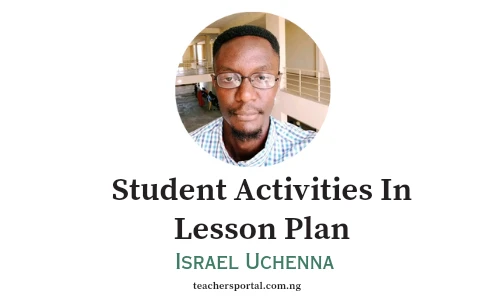This article explores Student Activities in lesson plans. If you’re a teacher and have little or no knowledge about Student Activities in lesson plans, then this article is for you.
What Is Student Activities In Lesson Plan
Student activities are an essential part of any effective lesson plan. They provide students with opportunities to actively engage with the material, apply their knowledge and skills, and collaborate with their peers. By carefully selecting and sequencing student activities, teachers can create a learning environment that is both stimulating and productive.
Types of Student Activities
There are many different types of student activities that can be used in a lesson plan. Some common examples include:
- Discussion: Discussions allow students to share their ideas and perspectives with each other. They can be used to introduce new concepts, explore different viewpoints, or analyze complex issues.
- Group work: Group work provides students with opportunities to collaborate on projects and assignments. This can help them develop their teamwork skills, communication skills, and problem-solving skills.
- Hands-on activities: Hands-on activities allow students to learn by doing. They can be used to demonstrate concepts, experiment with ideas, and develop new skills.
- Creative activities: Creative activities give students an outlet for self-expression. They can be used to communicate ideas, develop imagination, and foster creativity.
- Problem-solving activities: Problem-solving activities require students to apply their knowledge and skills to solve real-world problems. They can help to develop critical thinking skills, decision-making skills, and problem-solving strategies.
Benefits of Student Activities In Lesson Plan
Student activities offer a number of benefits for learners. They can:
- Promote active learning: Active learning is a teaching method that encourages students to take charge of their own learning. Student activities provide students with opportunities to actively engage with the material rather than passively receiving information.
- Enhance understanding: By actively participating in learning activities, students are more likely to understand and retain information.
- Develop critical thinking skills: Many student activities require students to think critically about the material. This can help them develop their ability to analyze information, evaluate arguments, and form their own opinions.
- Foster creativity: Creative activities give students an outlet for their imagination. This can help them develop their creativity and problem-solving skills.
- Promote collaboration: Group work activities provide students with opportunities to collaborate with their peers. This can help them develop their teamwork skills, communication skills, and problem-solving skills.
Selecting and Sequencing Student Activities
When selecting and sequencing student activities, teachers should consider the following factors:
- The learning objectives: The activities should be aligned with the learning objectives of the lesson.
- The age and developmental level of the students: The activities should be appropriate for the age and developmental level of the students.
- The available resources: The activities should be feasible to implement given the available resources.
- The pacing of the lesson: The activities should be sequenced in a way that allows the lesson to flow smoothly and cover all of the material in the allotted time.
How To Write Student Activities In Lesson Plan (With Sample)
In the lesson plan, following the ASEI lesson plan format, student activities are outlined after the teacher’s activities. Teachers initiate tasks for pupils to perform.
Here is an example of student activities in a lesson plan on the topic “Packaging Using Cans and Tins” for Agricultural Science.
| STEPS/STAGES | Teacher’s Activities | Student’s Activities | Learning Point |
| INTRODUCTION | The teacher ask the pupils to identify the real objects brought to the class. | The pupils responded by saying Tin Tomatoes, Tin Milk, Can Malt, | Arousing the interest of the pupils. |
| STEP I | The teacher asks the student to define Packaging Items. | The students defines Packaging Items as materials used for wrapping or protecting goods for distribution, storage, sale or personal use. | Packaging Items defined. |
| STEP II | The teacher lists out examples of products packaged using Cans and Tins such as Malt, Minerals, Tomatoes, Fish, Juice. | The students listened and repeated after the teacher all examples of mentioned products packaged using Tins and Cans. | Examples of products packaged using Tins and Cans listed. |
| STEP III | The teacher asks the students to draw a Tin of Milk on their notebooks. | The students draw a Tin of Milk on their exercise books. | A Tin of Milk drawn. |
| EVALUATION | The teacher asks the student the following questions:I.. Define Packaging ItemsII. List three farm produce packaged using Tins and CansIII. Draw a Tin of Milo | The students responded to all questions asked. | Attainment of lesson objectives. |
| CONCLUSION | The teacher summarizes the lesson by going through the main points of the lesson. | The students asks questions, makes contributions and write notes on their exercise books. | Consolidated the topic learned. |
Conclusion
Student activities are an essential part of any effective lesson plan. When carefully selected and sequenced, they can provide students with opportunities to actively engage with the material, apply their knowledge and skills, and collaborate with their peers. By using a variety of student activities, teachers can create a learning environment that is both stimulating and productive.
